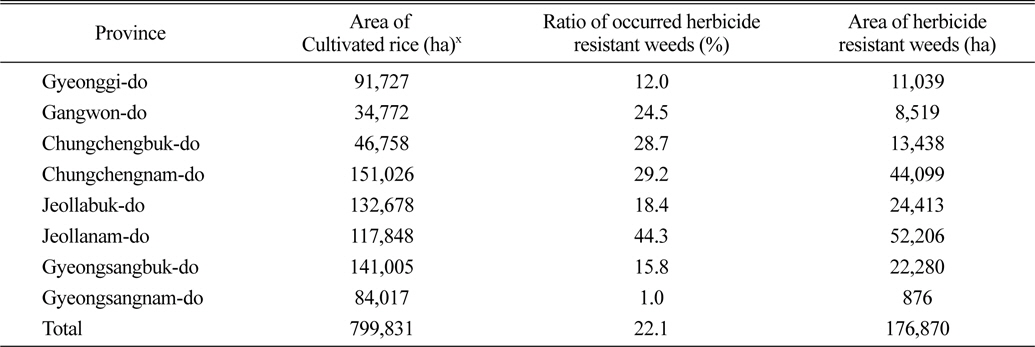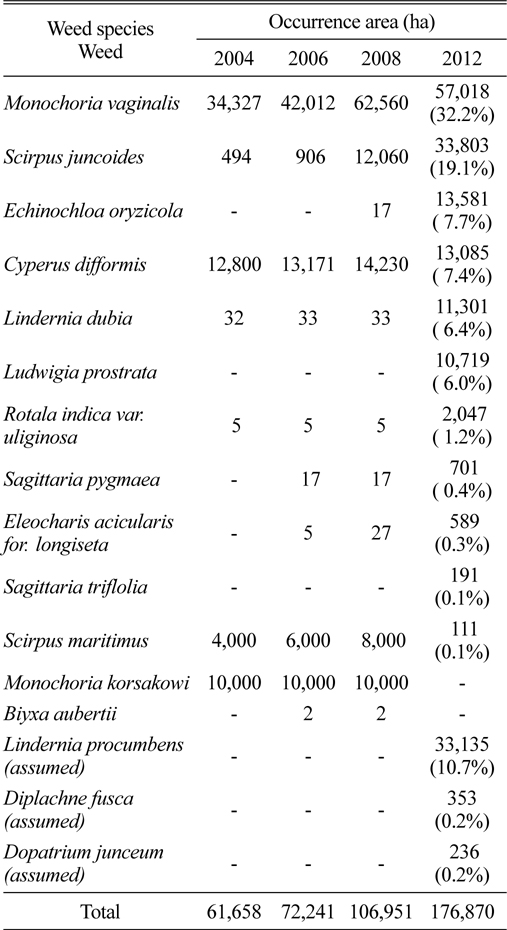



제초제 저항성 논잡초 발생면적은 국립농업과학원과 전국 8개도 농업기술원 공동으로 2011년과 2012년에 조사하였다. 8개도 3,200지점에서 논흙을 채취하여 피라조설퓨론에틸·피리미노박메틸입제를 30 kg ha-1 처리하여 설포닐우레아(SU)계 제초제 저항성 논잡초의 발생면적을 추산하였다. 전국 벼 재배면적(유기 및 친환경농업 벼 재배면적 제외)의 22.1%인 176,870 ha에서 SU계 제초제 저항성논잡초가 발생되었다. 발생비율을 보면, 전라남도가 논 면적의 44.3%로 제일 많이 발생되었고, 그 다음으로는 충청남도로 30.5%, 충청북도 27.8%, 강원도 24.5% 순이었다. 제초제 저항성 논잡초 중 발생면적이 가장 넓은 초종은 물달개비로서 전체 32.2%(57,018 ha)를 차지하였으며, 그 다음으로 올챙이고랭이, 밭뚝외풀 순이었다.
National Academy of Agricultural Science and eight province Agricultural Research & Extension Services investigated the occurring area of herbicide resistant weeds in paddy field of Korea. In order to estimate the occurring areas of herbicide resistant weeds, we collected paddy soils randomly from 3,200 sites in 2011 and 2012, and treated 30 kg ha-1 of pyrazosulfuron-ethyl+pyriminobac-methyl GR to the paddy soil. 176,870 ha, approximately 22.1% of cultivated area excluding organic and eco-friendly cultivated area, was estimated to be infested by SU-herbicide resistant paddy field weeds. Several species of resistant weeds were occurred at Jeonranam-do with 44.3%, followed by 30.5% at Chungchungnam-do, 27.8% at Chungchungbuk-do, and 24.5% at Jeonrabuk-do, respectively.
SU계 제초제 저항성잡초 발생조사는 2011년과 2012년, 2년동안 8개도 농업기술원에서 각각 실시하였다. 각 도별로 벼 재배양식, 지대, 토양특성 등을 고려하여 8개 지역을 임의로 나누고 각 도별로 400지점, 전국 3,200지점에서 논흙을 채취하였다. 조사지점은 각 도별 모든 시군이 포함되도록 하였다. 논흙은 각 지점당 0~20 cm 사이의 흙을 2~3 kg씩 3~4군데에서 채취한 후 혼합하여 각도 농업기술원의 온실에서 시험하였다.
채취한 논흙은 와그너 포트(1/5,000a) 또는 4각 포트 (40×50×10 cm)에 넣고 물로 진탕한 다음, 10일 후에 SU계 혼합 제초제인 피라조설퓨론에틸·피리미노박메틸입제를 30 kg ha-1 처리하였다. 약제처리 후 20일에 생존한 잡초를 SU계 제초제 저항성잡초로 간주하고 각 도별 SU계 제초제 저항성잡초 발생면적을 추정하였다.
도별 SU계 제초제 저항성잡초 발생면적을 보면, Table 1과 같이 전국 벼 재배면적(유기 및 친환경농업 벼 재배면적 제외)의 22.1%인 176,870 ha로 확인되었다. 2008년에는 106,951 ha (Park et al., 2011), 2011년에는 167,081 ha(Lee et al., 2012)와 비교하면 각각 60,130 ha와 9,789 ha가 늘어났다. 이런 결과는 Lee et al., (2012)이 보고한 바와 같이 SU계 제초제 저항성을 보인 광엽잡초와 ACCase 저해제와 ALS에 대해 교차 저항성을 보인 피의 발생면적이 늘어났기 때문으로 판단된다. 이미 Lee et al. (2011)과 Lim et al. (2010)은 충남과 전남북에서 ACCase 저해제와 ALS 억제제에 저항성을 보이는 강피의 발생을 확인하였고 방제방법을 보고한 바 있다.
[Table 1.] Occurrence rate of sulfonylurea herbicide resistant weeds in 2011 and 2012 by provinces.

Occurrence rate of sulfonylurea herbicide resistant weeds in 2011 and 2012 by provinces.
발생비율을 보면, 전라남도가 논 면적의 44.3%로 제일 많이 발생되었고, 그 다음으로는 충청남도로 29.2%, 충청북도 28.7%, 강원도 24.5%, 전라북도 18.4% 순이었다. 이들 제초제 저항성 논잡초의 발생현황이 전라남도와 충청남도, 전라북도 등과 같이 상대적으로 높은 이유는 Lee et al. (2012)이 보고한 바와 같이 간척지와 담수직파논에 많아 벼에 상대적으로 안전한 SU계를 선호하고 연용하였기 때문으로 판단된다.
SU계 제초제 저항성 논잡초의 초종별 발생면적은 Table 2와 같다. 발생면적이 가장 넓은 초종은 물달개비로서 57,018 ha로 전체 저항성 논잡초의 32.2%를 차지하였으며, 그 다음으로 올챙이고랭이(33,803 ha, 19.1%), 논피(강피), 알방동사니, 미국외풀 순이었다. Park et al. (2011)은 우리나라와 일본의 농업상황을 비교하면서 향후에는 물달개비와 올챙이고랭이의 발생면적이 늘어나 우점할 것이라는 보고와 유사하다.
[Table 2.] Occurrence area of sulfonylurea herbicides resistant weeds in rice paddy fields.

Occurrence area of sulfonylurea herbicides resistant weeds in rice paddy fields.
여뀌바늘은 학계에 정식으로 SU계 제초제 저항성잡초로 보고된 바는 없지만, Park (2012)에 의해 저항성잡초로 확인되었다. 그리고 밭뚝외풀도 SU계 저항성잡초로 보고 되지는 않았지만, 미국외풀과 같은 현삼과 일년생잡초이고 어릴 때에는 식별이 쉽지 않아 미국외풀을 밭뚝외풀로 오류하였을 가능성도 배제할 수 없다. Lee et al., (2009)에 의하면 밭뚝외풀속에는 밭뚝외풀, 미국외풀, 논뚝외풀 등 6종이 있으며, 육안으로 쉽게 분류할 수 없다고 하였다.
2008년 조사결과와 비교하면, 발생면적이 줄어든 잡초는 물달개비, 새섬매자기인 반면에 늘어난 잡초는 올챙이 고랭이, 미국외풀, 마디꽃, 벗풀, 쇠털골, 논피(강피)이다. 온실 검증으로 발생 확인이 안 된 제초제 저항성잡초로 물옥잠은 주로 충남 서산 간척지논에서 발생되고 있으며, 올챙이자리는 전남 나주와 해남 간척지 논에서 문제되고 있다. 새롭게 제초제 저항성잡초로 의심되는 갯드렁새, 밭뚝외풀, 등애풀은 감수성 계통과 비교하여 농도시험 등을 통해 제초제 저항성 잡초 여부의 확인이 필요하다.

